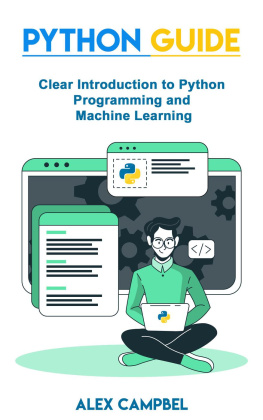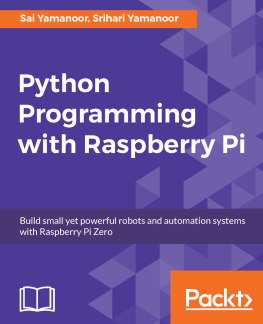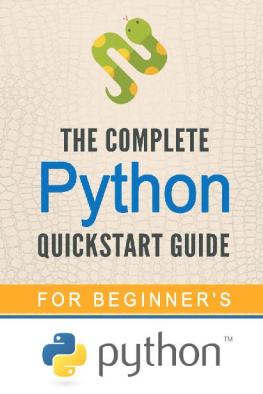PYTHON CRASH COURSE
A PRACTICAL BEGINNER'S GUIDE TO LEARN PYTHON IN 7 DAYS OR LESS, INTRODUCING YOU INTO THE WORLD OF DATA SCIENCE, ARTIFICIAL INTELLIGENCE AND MACHINE LEARNING, WITH HANDS-ON PROJECTS
ERICK THOMPSON
Copyright - 2020 -
All rights reserved.
The content contained within this book may not be reproduced, duplicated or transmitted without direct written permission from the author or the publisher.
Under no circumstances will any blame or legal responsibility be held against the publisher, or author, for any damages, reparation, or monetary loss due to the information contained within this book. Either directly or indirectly.
Legal Notice:
This book is copyright protected. This book is only for personal use. You cannot amend, distribute, sell, use, quote or paraphrase any part, or the content within this book, without the consent of the author or publisher.
Disclaimer Notice:
Please note the information contained within this document is for educational and entertainment purposes only. All effort has been executed to present accurate, up to date, and reliable, complete information. No warranties of any kind are declared or implied. Readers acknowledge that the author is not engaging in the rendering of legal, financial, medical or professional advice. The content within this book has been derived from various sources. Please consult a licensed professional before attempting any techniques outlined in this book.
By reading this document, the reader agrees that under no circumstances is the author responsible for any losses, direct or indirect, which are incurred as a result of the use of information contained within this document, including, but not limited to, - errors, omissions, or inaccuracies.
TABLE OF CONTENTS
INTRODUCTION
P ython is a significant level programming language, normally utilized for general purposes. It was initially developed by Guido van Rossum at the "Middle Wiskunde and Informatica (CWI), Netherlands," during the 1980s and presented by the "Python Software Foundation" in 1991. It was planned essentially to underscore comprehensibility of programming code, and its linguistic structure empowers developers to pass on thoughts utilizing less lines of code. Python programming language speeds up activity while taking into account higher productivity in making framework reconciliations. Designers are utilizing Python for "web advancement (server-side), programming improvement, arithmetic, framework scripting."
With the presentation of different upgrades, for example, "list appreciation" and a "trash assortment framework," which can gather reference cycles, the Python 2.0 was propelled in the last quarter of 2000. Thusly, in 2008, Python 3.0 was discharged as a significant rendition overhaul within reverse similarity taking into consideration the Python 2.0 code to be executed on Python 3.0 without requiring any adjustments. Python is bolstered by a network of software engineers that ceaselessly create and keep up the "CPython," which is an open-source reference usage. The "Python Software Foundation" is a not revenue driven association that is liable for overseeing and coordinating assets for creating Python programming just as "CPython."
Here is a portion of the key highlights of Python that render it as the language of decision for coding beginners as well as advanced programming software engineers alike:
1. Readability: Python peruses a great deal like the English language, which adds to its simplicity of coherence.
2. Learnability: Python is a significant level programming language and considered simple to learn because of the capacity to code utilizing the English language like articulations, which infers it is easy to appreciate and, in this way, become familiar with the language.
3. Operating Systems: Python is effectively open and can be worked across various Operating frameworks including Linux, Unix, Mac, Windows among others. This renders Python as an adaptable and cross-stage language.
4. Open Source: Python is an "open source", which implies that the engineer network can flawlessly make updates to the code, which are consistently accessible to anybody utilizing Python for their product programming needs.
5. Standardized Data Libraries: Python includes a major standard information library with an assortment of helpful codes and functionalities that can be utilized when composing Python code for information examination and advancement of AI models.
6. Free: Considering the wide appropriateness and use of Python, it is difficult to accept that it keeps on being openly accessible for simple download and use. This suggests anybody hoping to learn or utilize Python can just download and utilize it for their applications totally complimentary. Python is in reality an ideal case of a "FLOSS (Free/Libre Open Source Software)", which implies one could "uninhibitedly convey duplicates of this product, read its source code and alter it."
7. Supports overseeing special cases: An "exemption" can be characterized as "an occasion that can happen during program exemption and can disturb the typical progression of the program." Python is fit for supporting the treatment of these "exemptions," inferring that you could compose less blunder inclined codes and test your code with an assortment of cases, which might prompt a "special case" later on.
8. Advanced Features: Python can likewise bolster "generators and rundown appreciations."
9. Storage administration: Python is likewise ready to help "programmed memory the executives," which infers that the capacity memory will be cleared and made accessible consequently. You are not required to clear and let lose the framework memory.
Applications:
1. Web planning Some of the generally utilized web structures, for example, "Django" and "Flagon" have been created utilizing Python. These structures help the designer recorded as a hard copy server-side codes that empower the board of database, age of backend programming rationale, planning of URL, among others. AI An assortment of AI models has been composed solely in Python. AI is a path for machines to compose rationale so as to learn and fix a particular issue all alone. For example, Python-based AI calculations utilized being developed of "item proposal frameworks" for eCommerce organizations, for example, Amazon, Netflix, YouTube and some more. Different cases of Python-based AI models are the facial acknowledgment and the voice acknowledgment innovations accessible on our cell phones.
2. Data Analysis Python can likewise be utilized in the advancement of information perception and information investigation instruments and procedures, for example, disperse plots and other graphical portrayals of information.
3. "Scripting" It can be characterized as the way toward producing basic projects for mechanization of direct undertakings like those required to send robotized email reactions and instant messages. You could build up these sorts of programming utilizing the Python programming language.
4. Gaming Industry A wide assortment of gaming programs have been created with the utilization of Python.
5. Python additionally bolsters the advancement of "implanted applications."
6. Desktop applications You could utilize information libraries, for example, "Tinder" or "QT" to make work area applications dependent on Python.
CHAPTER - 1
THE WORLD OF DATA SCIENCE TECHNOLOGIES
Data science
If you work with data, then Data Visualization is an important part of your daily routine. And if you happen to use Python programming language for your analysis, you must be overwhelmed by the sheer number of choices available in the form of data visualization libraries





